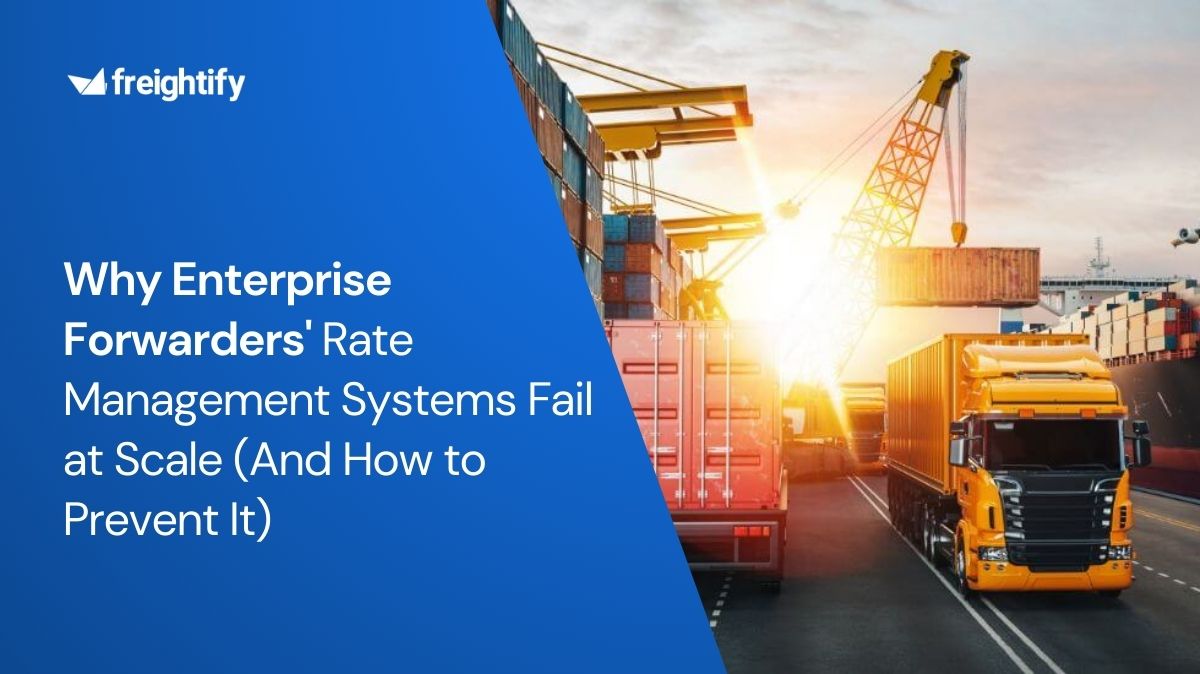Introduction The global ocean freight software market is expected to reach $1.32 billion by 2025, growing at a CAGR of 7.8% due to rising demand for automation, digital documentation, and real-time freight tracking. As shipping costs fluctuate and global trade expands, freight forwarders need efficient digital tools to manage freight rates, reduce errors, and improve customer service. Choosing the right ocean freight software can help streamline operations, cut costs by up to 25%, and boost efficiency by 40%.
What is Ocean Freight Software? Ocean freight software is a digital platform that enables freight forwarders, NVOCCs, and shipping companies to manage freight rates, documentation, booking, and shipment tracking. By automating manual tasks and integrating real-time data, these solutions enhance efficiency, reduce human errors, and optimize freight operations for better profitability.
Ocean shipping requires keeping up with a number of government compliance regulations and complex documentation. Ocean freight forwarding software helps digitize, organize, track, and ensure the accuracy of the many documents involved in international shipments. It also helps forwarders stay updated on the latest government regulations to ensure the shipments are customs-compliant and helps avoid unnecessary delays.
Data analytics is another essential feature that ocean freight forwarding software brings to the table. Trend analysis and identification enable data-driven decision-making. Ocean shipping software also helps narrow down areas of improvement and optimization, paving the way for keeping up with trends and growing in the future.
Let us help you with your journey
Instantly procure spot rates from 30+ LCL and FCL Carriers & NVOCCs
Top 6 Ocean Freight Solution Providers: Comparison Table
Software
Type
Key Features
Strengths
G2 Rating
Ideal For
Freightify
Rate Management System (RMS)
Rate Procurement, Rate Management, API Integration, Instant Quote Generation, Track & Trace
Comprehensive rate management, ease of use, and robust customer support
4.8/5
Freight forwarders needing a complete RMS solution with strong integration capabilities and customer support
Okargo
Rate Management System (RMS)
Rate Management, Dynamic Engine, User-Friendly Application, Real-Time Visibility, Integration Capability
Easy data consolidation from multiple sources, real-time tracking, integration with TMS
N/A
Companies looking for a user-friendly RMS focused on rate comparison and data consolidation
Wisor.ai
Rate Management System (RMS)
Real-Time Visibility, Automated Quotation System, Seamless Connectivity, Efficient Rate Management, Data-driven Insights
AI-powered RMS, fast quotation generation, and data-driven insights
N/A
Businesses seeking AI-powered RMS with quick quotation generation and real-time data visibility
Magaya
Transport Management System (TMS)
Centralized Inventory Database, Inventory Level Dashboards, Stock History Reporting, Carrier Management, Customer Management
User-friendly interface, comprehensive inventory and carrier management, strong customer portal
N/A
Freight forwarders needing a TMS with robust inventory and carrier management capabilities
Cargowise
Transport Management System (TMS)
Carrier Management, Customer Management, Analytics, Process Automation
Comprehensive TMS, predictive analytics, extensive support modules
4.3/5
Large logistics companies looking for a comprehensive TMS with advanced features
Descartes Alijex
Transport Management System (TMS)
Fleet Optimization, Real-Time Visibility, Comprehensive Transportation Management, Integrations, Advanced Analytics
Extensive transportation management features, fleet optimization, real-time tracking
4.5/5
Businesses requiring advanced TMS functionalities, especially in fleet and transportation management
Detailed Comparison of the Best Ocean Freight Software in 2025 Best for Ocean Freight Rate Management
Freightify is a cloud-based ocean freight software that helps freight forwarders streamline rate management, automate quoting, and access real-time freight rates.
Customer reviews appreciate the ease with which Freightify enables them to compare different carrier rates on the platform. Knowing the best market rates aids with quick decision-making while picking carriers and faster quotations. Freightify also operates a responsive customer support team to solve queries and ensure that its customers have a hassle-free experience at every step of the way.
Core features 1. Rate procurement Aggregates 30 live ocean carrier rates, 90+ airlines, and inland charges into a single view, encompassing SPOT, FCL, LCL, and AIR rates from various carriers and NVOCCs.
2. Rate management Efficiently add rates individually or in bulk through agent inputs, API uploads, or rate sheets, ensuring detailed information like origin, destination, and cargo specifics is included. View rates in concise tables or exportable rate cards. Automate margin management with customizable rules across products, ports, and global operations.
3. API Integration API integration provides scalable track-and-trace solutions, enabling users to send track-and-trace information to any desired system.
4. Instant quote generation Quickly generate and customize quotes from search results, including fee adjustment and profit calculation, with the option to email directly or download as a document.
5. Track & trace Experience comprehensive visibility with live end-to-end tracking, monitoring cargo from pickup to delivery. Leverage insights for prioritizing clients and maintaining relationships. Freightify's Analytics dashboard offers detailed insights on shipments, quotations, win ratios, and staff performance, enhancing operational efficiency and decision-making.
Service Locations: Available in USA, Europe, Asia, Australia, and the Middle East, Supports global freight forwarders with region-specific pricing and compliance tools.
Pricing: Custom pricing based on business size & requirements , Freightify offers flexible plans based on operational needs, ensuring cost-effectiveness for businesses of all sizes.
Ratings & Reviews: G2: 4.7/5 – Best for real-time freight rate visibility & automation. Highly rated for its automation, accuracy, and real-time rate comparison capabilities.
Let us help you with your journey
Fetch Rates from 30+ LCL and FCL Carriers & NVOCCs!
2. Okargo Best for Carrier Rate Analysis
Okargo provides freight forwarders with advanced rate analysis tools to help compare carrier pricing trends and manage rate fluctuations effectively.
Key Features: Carrier contract rate analysis :– Analyzes past and current contract rates, helping forwarders secure cost-effective shipping agreements.Rate management dashboard :– A centralized dashboard for monitoring and managing freight rates from multiple carriers.Custom API for TMS integration :– Enables easy connection with existing transport management systems for streamlined operations.
Pros: Strong carrier rate visibility
Cons: Limited features outside of rate analysis
Service Locations: Europe, North America, and Asia – Supports freight forwarders operating in major global trade markets.
Pricing: Subscription-based pricing model – Offers flexible pricing tiers depending on business needs and scale.
Ratings & Reviews: N/A
3. Wisor.ai Best AI-Powered Freight Software
Wisor.ai leverages AI-driven automation to digitize freight forwarding, enhance rate optimization, and improve operational efficiency for logistics professionals.
Key Features: AI-driven pricing & rate forecasting: Uses machine learning to predict rate trends and improve cost-saving strategies.
Pros: Strong AI-powered optimization tools
Improves freight pricing accuracy
Cons: Best suited for large freight forwarders
Service Locations Europe, US, France, Spain, Canada, Portugal, England and Australia regions.
Pricing: Enterprise-based pricing: Tailored for large freight forwarding companies with customizable AI solutions.
4. Magaya Best for End-to-End Freight Forwarding
Magaya is an all-in-one logistics software that integrates freight forwarding, customs compliance, and warehouse management.
While the software is easy to use, reviews often mention limitations in integrating Magaya with other systems, especially accounting systems based outside the US.
Key Features: Freight forwarding & warehouse integration : Combines freight and warehouse management for seamless logistics operations.
Pros: Comprehensive logistics & freight management
Good for small & mid-sized forwarders
Cons: Higher cost for small businesses
Service Locations:
USA, Canada, and Latin America & Covers major logistics hubs in North and South America.
Pricing: Custom pricing plans available, Pricing varies based on features and business size.
5. Cargowise Best for Large Freight Enterprises
Cargowise is a comprehensive TMS solution that supports global freight forwarders with multi-modal transport management.
This being said, some users find Cargowise's TMS challenging to use, especially those who don’t want the hassle of going through complex processes and would instead prefer a straightforward user dashboard to meet their freight management needs.
Idol Features: Integrated multi-modal transport management: Supports air, sea, rail, and road freight.ERP & customs compliance integration: Ensures seamless customs clearance and regulatory compliance.
Pros: Robust enterprise-grade freight platform
Global carrier & customs support.
Cons: Expensive for smaller freight forwarders
Service Locations: Global (Europe, USA, Asia, Australia), Widely used across major global markets.
Pricing: Quote-based pricing, Custom quotes based on enterprise requirements.
Ratings & Reviews: N/A
6. Descartes Descartes provides cloud-based freight management solutions focusing on customs compliance, shipment tracking, and logistics security.
However, given the variety of features it offers, users report an obsolete, sluggish UI and problems in system robustness. Difficulties in extracting reports are also one of the platform’s limitations, which users frequently mention in their reviews.
Key Features: Global shipment visibility & tracking: Provides real-time status updates on shipments.
Pros: Good for global trade & compliance
Cons: Limited rate management features
Service Locations: Global presence: Available in multiple international markets.
Pricing: Custom enterprise pricing: Varies depending on business needs.
Ratings & Reviews: N/A Key Features to Choose an Sea Freight Software Technology integration into the ocean freight industry has transformed the role of the freight management system. It is no longer a feature but a necessity that drives a business forward in the evolving world of ocean logistics. However, given the number of digital freight solutions available, it becomes crucial to narrow down the key features to look for in ocean shipping software.
1. Instant spot rates One of the most essential features to look for in ocean freight forwarding software is its rate management capabilities. Freight rate management systems such as those provided by Freightify provide instant access to standardized rates from multiple sources. Their robustness ensures that human errors in rate calculation are eliminated and accurate, while reliable pricing information is made available at the click of a button.
2. Improved visibility A freight system with real-time tracking and tracing capabilities improves visibility across processes. It allows stakeholders to track the several processes involved in the shipment’s journey from the source to its destination, thereby reinforcing trust in its operations.
3. Integration with other systems A freight software that integrates with other systems with minimal effort enables streamlining business workflows and ensures a hassle-free flow of data from one system to another. It allows collaboration across the logistics pipeline and ensures smooth operations.
4. Reliable customer support In an industry where a lot depends on meeting milestones on time, easily reachable customer support allows bottlenecks to clear faster and operations to continue without any major hiccups.
How to Choose the Right Ocean Freight Software for Your Business? The many steps involved in a freight forwarding process and the variety of freight forwarding solutions mean there is no one-size-fits-all approach to choosing ocean freight forwarding software. However, aligning needs with critical features can help narrow down the best freight management system for a business.
The most reliable method for finding best freight forwarding software that fits one's needs is to look for real-time statistics and customer reviews, such as those enlisted on Freightify’s website. Numbers such as a 50% reduction in operational costs and a 92% reduction in processing time with Freightify are a testament to customer satisfaction. These figures speak for themselves and reinstate trust while choosing the right freight forwarding software for your business.
Conclusion: Why Freightify is the Best Choice Freightify provides real-time freight rate visibility, automated quoting, and seamless integrations, making it the go-to solution for freight forwarders.
Get a Free Demo of Freightify Today!
Ocean Freight Software FAQs How do you choose the best ocean freight software? The most reliable method for finding freight forwarding software that fits one's needs is to look for real-time statistics and customer reviews. G2 scores and reviews are one such source of feedback. Numbers such as percentage reduction in operational costs or reduced processing time are a testament to customer satisfaction. These figures speak for themselves and reinstate trust while choosing the right freight forwarding software for your business.
Do I need an Sea freight software? Today’s Sea freight software enables freight forwarders to reduce manual decision-making and simplify management by creating a single point of control and coordination. It helps them control end-to-end operations involved in various logistics areas, such as carrier management, documentation, warehouse management, route optimization, real-time tracking, process automation, and integration.
What is the difference between TMS and RMS? While an RMS deals specifically with rate and quotation management, a TMS encompasses a broader range of tools that facilitate the complete process of transporting a shipment from one location to another, such as booking, tracking, and documentation.
Do I need both RMS and TMS software? RMS can help reduce the time spent analyzing pricing from various carriers. TMS helps in managing the end-to-end shipment process. Both serve specific purposes and depending on the nature of your business, you may need one or both.




















